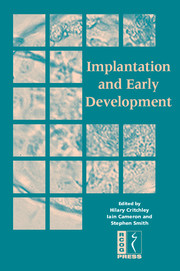Book contents
- Frontmatter
- Contents
- DECLARATION OF INTEREST
- Participants
- Preface
- SECTION 1 PREPARATION FOR IMPLANTATION – THE UTERINE ENVIRONMENT
- SECTION 2 THE EMBRYO
- 9 What makes a good egg?
- 10 What makes ‘good sperm’?
- 11 Morphogenesis of the early mammalian embryo: cell lineage heterogeneity and developmental potential
- 12 Epigenetics in development and cloning by nuclear transfer: alternative approaches to nuclear reprogramming
- 13 Risks associated with assisted reproduction: insights from animal studies
- 14 Pre-implantation genetic testing
- SECTION 3 LESSONS FROM ANIMAL MODELS (TRANSGENICS) AND NOVEL TECHNOLOGIES
- SECTION 4 CLINICAL SEQUELAE
- SECTION 5 CONSENSUS VIEWS
- Index
9 - What makes a good egg?
from SECTION 2 - THE EMBRYO
Published online by Cambridge University Press: 05 June 2014
- Frontmatter
- Contents
- DECLARATION OF INTEREST
- Participants
- Preface
- SECTION 1 PREPARATION FOR IMPLANTATION – THE UTERINE ENVIRONMENT
- SECTION 2 THE EMBRYO
- 9 What makes a good egg?
- 10 What makes ‘good sperm’?
- 11 Morphogenesis of the early mammalian embryo: cell lineage heterogeneity and developmental potential
- 12 Epigenetics in development and cloning by nuclear transfer: alternative approaches to nuclear reprogramming
- 13 Risks associated with assisted reproduction: insights from animal studies
- 14 Pre-implantation genetic testing
- SECTION 3 LESSONS FROM ANIMAL MODELS (TRANSGENICS) AND NOVEL TECHNOLOGIES
- SECTION 4 CLINICAL SEQUELAE
- SECTION 5 CONSENSUS VIEWS
- Index
Summary
Introduction
More than 25 years have passed since the birth of the first child born after in vitro fertilisation (IVF). While early attempts to carry out IVF were initiated to overcome fallopian tube malfunction, many advances have been made in assisted reproductive technology (ART) and it is now possible to treat a wide range offertility problems such as male infertility, women with Turner syndrome, and hypogonadotrophic conditions. New techniques have been developed, such as oocyte donation and intracytoplasmic sperm transfer, which have increased the number of patients that can be treated for infertility, currently estimated at one couple in six. Despite these many advances in technology, success rates for all treatment cycles are generally less than 25%.
In vivo, only a species-specific number of ovarian follicles are selected to release their oocytes for fertilisation during each reproductive cycle. While many factors play a role in selecting the follicles (and hence oocytes) for ovulation, the overriding factor is availability and follicular response to the circulating gonadotrophins, follicle-stimulating hormone (FSH) and luteinising hormone (LH). Exogenous administration of these gonadotrophins bypasses the normal selection processes and allows a high number of follicles to reach the ovulatory stage, a technique that the majority of ART protocols use as a means of harvesting a large number of oocytes for fertilisation.
Keywords
- Type
- Chapter
- Information
- Implantation and Early Development , pp. 103 - 118Publisher: Cambridge University PressPrint publication year: 2005

